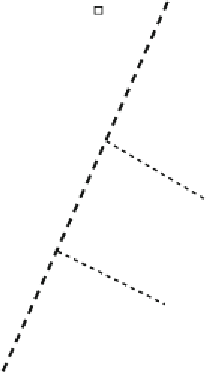Biomedical Engineering Reference
In-Depth Information
4
8
D15
C
D14
11
16
D13
3
D12
30
7
D11
31
D10
13
20
D9
24
26
2
D8
10
15
6
D7
A
D6
12
19
D5
23
1
25
D4
29
5
D3
B
D2
9
14
0
2.5m
5m
D1
Figure 9.13. Plan view layout of delivery wells (Transect C) and monitoring wells (Transects A and
B) in the demonstration-scale experiment conducted at Schoolcraft, Michigan. Reprinted with
permission from Dybas et al.,
2002
. Copyright 2002, American Chemical Society.
experiment with recirculation at four times greater volume and supplemented with trace
nutrients to minimize flocculation (Dybas et al.,
1998
,
2002
). The delivery of microorganisms,
as well as solutes, was more uniform and occurred over greater distances when groundwater
was recirculated by coupled injection/extraction (second and third injections) compared to
injection alone (first injection).
In all three inoculations,
P. stutzeri
KC was grown on site in site groundwater, amended
with acetate (800-1,600 mg/L) and phosphate (10 parts per million [ppm]), and then maintained
at pH 8.2 during the growth phase by the addition of base and acid. In the first two inoculations,
flocculation occurred; in the third injection, flocculation was prevented by addition of the trace
minerals Fe, Cu, zinc (Zn), Ni and manganese (Mn). Figure
9.14
illustrates the steps used for the
first inoculation in the demonstration-scale experiment.
Within 16 days of inoculation,
P. stutzeri
KC was detected in groundwater samples from
three monitoring locations located 1 and 2 m downgradient from the delivery well gallery.
Within 6 weeks, strain KC was detected at 50% of the monitoring locations (Table
9.4
).
Inoculation of all delivery wells occurred on day 117, and reinoculation of the Northeast
delivery wells (D8-D15) occurred on days 200-201.
As shown in Table
9.4
, the once-inoculated and twice-inoculated sections of the treatment
zone showed only a transient difference in strain KC levels in downstream monitoring wells.
Because
P. stutzeri
KC has a unique “fried-egg” colony morphology when grown on R2A agar,
quantitative estimates of strain KC levels on sediment samples were subsequently obtained
from plate counts of extracted sediment cores (confirmed by PCR) as per Witt et al. (
1999
).
An analysis of sediment colonization on days 336-342 revealed no difference in strain KC
levels between the once- and the twice-inoculated sections of the aquifer (Table
9.5
).
The results of this demonstration support the conclusion that reinoculation was not
necessary for adequate sediment colonization. Nevertheless, addition of trace metals to
the inoculum growth medium is still recommended as it decreased culture flocculation in the
reinoculation event.


















































Search WWH ::

Custom Search